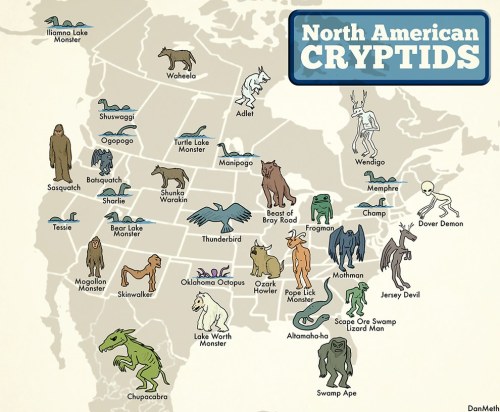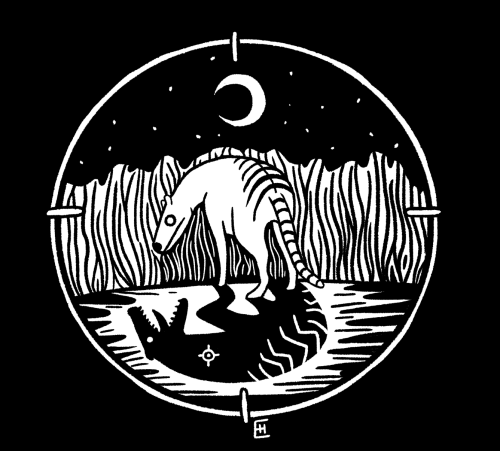Jackasslope - Cryptids & Co

More Posts from Jackasslope and Others
In Washington State killing Bigfoot is a felony but in Texas Bigfoot is considered an invasive species and can be hunted at will.
This sounds like one of those cutesy funny cryptid posts but that is actually the legal status of Bigfoot in those two states, you can look it up.


Convergent evolution: Dasyuromorphia and Carnivora
The Encyclopedia of Animal Evolution, 1987

The Official Loch Ness Monster Sighting Register keeps a page on its website that highlights what does not make a Nessie sighting. The website uses actual accounts that have been reported to it to help decipher what shouldn’t be reported as a legitimate sighting. Some are the more common things that photographs or videos have been debunked as, such as boat wakes, seals, and floating logs. But some others include birds, divers, and even insects. The Register does explain itself on these. It says that the splashes from birds diving or taking off from the water can sometimes look like something suspicious. It explains a situation in 2015 where a woman reported a Nessie sighting but it was debunked as divers that were getting footage for Google Maps’ street view. As for the insects, the Register talks about how bugs too close to the camera lens can sometimes appear monster-ish.

Cryptid of the Day: Wanjilanko
Description: The Wanjilanko is a massive feline seen in the Casamance Forest of Senegal. It’s described as reddish with faint stripes, long fangs and a negligible tail. Cryptozoologists think that the creature is a living Saber Tooth Tiger.

This grainy image has very little information surrounding it. All that is said about it is that it was taken in 1923 in Cobalt, Ontario, and is supposedly of Old Yellow Top - a Bigfoot-like creature that is said to roam Ontario. Old Yellow Top is said to be called such because, unlike other Bigfoot sightings, this one always has blond colored hair on its head. It is thought to be the oldest known photograph of a Bigfoot-like creature.
-
 kittypox reblogged this · 1 month ago
kittypox reblogged this · 1 month ago -
 senselessnope liked this · 1 month ago
senselessnope liked this · 1 month ago -
 idimmadontgiveashit reblogged this · 1 month ago
idimmadontgiveashit reblogged this · 1 month ago -
 idimmadontgiveashit liked this · 1 month ago
idimmadontgiveashit liked this · 1 month ago -
 snailfarts reblogged this · 1 month ago
snailfarts reblogged this · 1 month ago -
 songue85 reblogged this · 1 month ago
songue85 reblogged this · 1 month ago -
 shadowybasementbanana liked this · 7 months ago
shadowybasementbanana liked this · 7 months ago -
 queen-of-hobgobblers reblogged this · 8 months ago
queen-of-hobgobblers reblogged this · 8 months ago -
 whoyagonnacall-r2d2 liked this · 9 months ago
whoyagonnacall-r2d2 liked this · 9 months ago -
 hoosierintherye liked this · 10 months ago
hoosierintherye liked this · 10 months ago -
 starod2 liked this · 11 months ago
starod2 liked this · 11 months ago -
 roguegunn reblogged this · 11 months ago
roguegunn reblogged this · 11 months ago -
 roguegunn liked this · 11 months ago
roguegunn liked this · 11 months ago -
 alternateescape reblogged this · 11 months ago
alternateescape reblogged this · 11 months ago -
 therockywhorerpictureshow liked this · 11 months ago
therockywhorerpictureshow liked this · 11 months ago -
 ride-the-hammett reblogged this · 11 months ago
ride-the-hammett reblogged this · 11 months ago -
 rkxt liked this · 11 months ago
rkxt liked this · 11 months ago -
 ride-the-hammett liked this · 11 months ago
ride-the-hammett liked this · 11 months ago -
 alternateescape liked this · 11 months ago
alternateescape liked this · 11 months ago -
 ultramilkshakeblr liked this · 11 months ago
ultramilkshakeblr liked this · 11 months ago -
 a-mediocre-time liked this · 1 year ago
a-mediocre-time liked this · 1 year ago -
 caffeinated-tomfoolery liked this · 1 year ago
caffeinated-tomfoolery liked this · 1 year ago -
 satanic10 liked this · 1 year ago
satanic10 liked this · 1 year ago -
 miellsworld liked this · 1 year ago
miellsworld liked this · 1 year ago -
 fugazzy liked this · 1 year ago
fugazzy liked this · 1 year ago -
 frogmeat-proteinbar liked this · 1 year ago
frogmeat-proteinbar liked this · 1 year ago -
 unix101 reblogged this · 1 year ago
unix101 reblogged this · 1 year ago -
 unix101 liked this · 1 year ago
unix101 liked this · 1 year ago -
 ripinpeacesanity-blog liked this · 1 year ago
ripinpeacesanity-blog liked this · 1 year ago -
 naught-the-artist reblogged this · 1 year ago
naught-the-artist reblogged this · 1 year ago -
 naught-the-artist liked this · 1 year ago
naught-the-artist liked this · 1 year ago -
 aevarswall liked this · 1 year ago
aevarswall liked this · 1 year ago -
 bongose liked this · 1 year ago
bongose liked this · 1 year ago -
 terichio liked this · 1 year ago
terichio liked this · 1 year ago -
 turonian23 liked this · 1 year ago
turonian23 liked this · 1 year ago -
 lonesilverw0lf liked this · 1 year ago
lonesilverw0lf liked this · 1 year ago -
 weeniehutjuniorsenior reblogged this · 1 year ago
weeniehutjuniorsenior reblogged this · 1 year ago -
 nogoatsnoglori liked this · 1 year ago
nogoatsnoglori liked this · 1 year ago

















